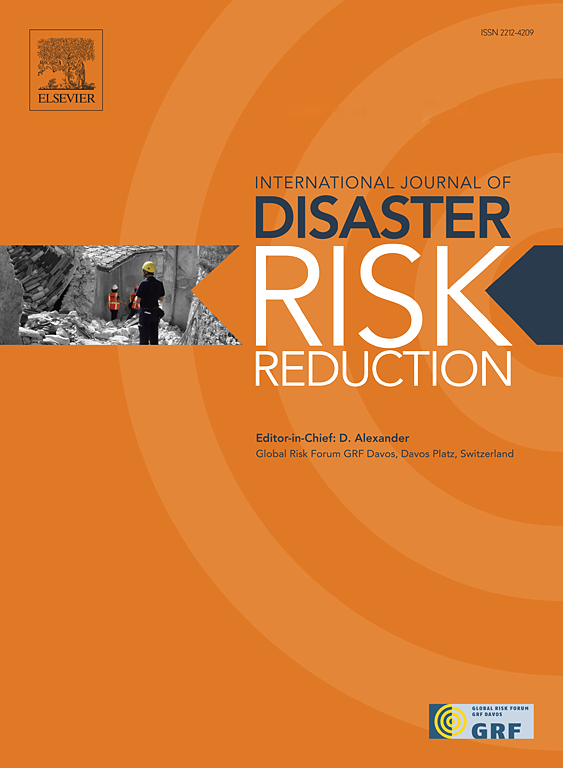气候变化情景下溃坝洪水风险分析的模糊框架
IF 4.5
1区 地球科学
Q1 GEOSCIENCES, MULTIDISCIPLINARY
International journal of disaster risk reduction
Pub Date : 2025-03-01
DOI:10.1016/j.ijdrr.2025.105322
引用次数: 0
摘要
传统的溃坝风险(DBR)分析方法没有将定性(如社会环境和生态)损失与定量(如经济)损失结合起来考虑。本文提出了一种新的模糊框架中的DBR分析方法来解决这个问题。它使用新提出的修正综合风险指数(MARI)有效地量化风险,该指数集成了三个风险指标(溃坝洪水的可能性、随之而来的危害的严重程度和暴露指数)的信息。它可以利用静态和可变模糊集理论的优势,将不确定、模糊和模糊的信息纳入风险指标。通过考虑不同的权重估计方法(常规与模糊层次分析法、单纯模糊二元比较法),研究了不同暴露指标权重不确定性对MARI估计的影响。通过对Hemavathy大坝(印度)及其漫滩的研究,证明了所提出方法的有效性。此外,为了识别气候变化对DBR的影响,通过考虑11个CMIP6环流模式(gcm)对4种气候变化情景(ssp: 126、245、370和585)的水文气象变量的模拟,获得MARI预估来确定其未来情景。结果表明,由于种群未来预测的差异,SSP 585情景的溃坝/决口灾害预测最高,但SSP 370和SSP 245情景的DBR预测最高。所提议的方法在确定设计DBR缓解计划所需的信息方面似乎很有希望,即使对于数据稀疏地区的水坝也是如此。本文章由计算机程序翻译,如有差异,请以英文原文为准。

A fuzzy framework for risk analysis of dam-break flood in climate change scenarios
The conventional Dam Break Risk (DBR) analysis methods do not consider qualitative (e.g., socio-environmental and ecological) losses in conjunction with quantitative (e.g., economic) losses. This article contributes a novel DBR analysis methodology in a fuzzy framework to address this issue. It quantifies risk effectively using a newly proposed Modified Aggregate Risk Index (MARI) that integrates information on three risk indicators (likelihood of dam-break flood, severity of consequent hazard, and exposure index). It can incorporate uncertain, ambiguous, and vague information on risk indicators by harnessing the advantages of both static and variable fuzzy set theories. The effect of uncertainty in weights assigned to different exposure indicators for MARI estimation is investigated by considering different options for weight estimation (conventional and fuzzy analytical hierarchy process, simplex fuzzy binary comparison method). The effectiveness of the proposed methodology is demonstrated through a study on the Hemavathy Dam (India) and its floodplain. Furthermore, to discern the effect of climate change on DBR, its future scenarios are determined by obtaining projections of MARI considering simulations of hydrometeorological variables from eleven CMIP6 GCMs (General Circulation Models) for four climate change scenarios (SSPs: 126, 245, 370, and 585). Results indicate that dam break/breach hazards are projected to be highest for SSP 585 scenario, but the highest DBR is projected for SSP 370 and 245 scenarios owing to differences in future projections of populations. The proposed methodology appears promising in determining information for devising DBR mitigation plans, even for dams in data-sparse areas.
求助全文
通过发布文献求助,成功后即可免费获取论文全文。
去求助
来源期刊

International journal of disaster risk reduction
GEOSCIENCES, MULTIDISCIPLINARYMETEOROLOGY-METEOROLOGY & ATMOSPHERIC SCIENCES
CiteScore
8.70
自引率
18.00%
发文量
688
审稿时长
79 days
期刊介绍:
The International Journal of Disaster Risk Reduction (IJDRR) is the journal for researchers, policymakers and practitioners across diverse disciplines: earth sciences and their implications; environmental sciences; engineering; urban studies; geography; and the social sciences. IJDRR publishes fundamental and applied research, critical reviews, policy papers and case studies with a particular focus on multi-disciplinary research that aims to reduce the impact of natural, technological, social and intentional disasters. IJDRR stimulates exchange of ideas and knowledge transfer on disaster research, mitigation, adaptation, prevention and risk reduction at all geographical scales: local, national and international.
Key topics:-
-multifaceted disaster and cascading disasters
-the development of disaster risk reduction strategies and techniques
-discussion and development of effective warning and educational systems for risk management at all levels
-disasters associated with climate change
-vulnerability analysis and vulnerability trends
-emerging risks
-resilience against disasters.
The journal particularly encourages papers that approach risk from a multi-disciplinary perspective.
 求助内容:
求助内容: 应助结果提醒方式:
应助结果提醒方式:


